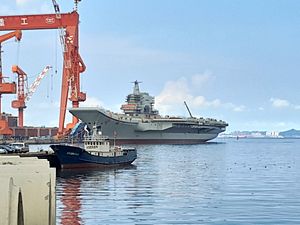China’s first domestically designed and built aircraft carrier, the Type 001A Shandong (CV-17), might take to the sea for the first time already next month, according to Chinese military experts.
“China’s first homemade aircraft carrier might conduct its sea trials around Spring Festival in mid February,” Li Jie, a naval expert, told the state-owned Global Times in early January.
The warship’s first round of sea trials is expected to take place in the Bohei Sea.
The 65,ooo-ton Type 001A carrier was launched in April 2017 at the Dalian shipyard in Liaoning Province by China Shipbuilding Industry Corporation.
The future Shandong is an improved variant of the People’s Liberation Army Navy’s (PLANs) only operational aircraft carrier, the 60,000-ton Type 001 Liaoning — a retrofitted Soviet-era Admiral Kuznetsov-class multi-role aircraft carrier.
The Liaoning and its escort vessels passed through the Taiwan Strait on January 18, entering Taiwan’s air defense zone in a symbolic show of force.
According to some reports, the new carrier could be inducted into the PLANs service ahead of schedule by the end of this year.
As I reported in August 2017, “one of the reasons for the likely earlier induction of the ship is better than expected test results of key systems of the carrier including the carrier’s propulsion system.”
The Shandong will operate a so-called ski-jump assisted Short Take-Off But Arrested Recovery (STOBAR) launch system also in use aboard the Liaoning. The aircraft launch system impacts the carrier’s operational capabilities, as I explained previously:
Given the STOBAR system, aircraft launched from the carrier will also have a more limited operational range due to the fact that they need to expend a considerable amount of fuel during take-off in comparison to aircraft launched with a catapult system as is the case in the U.S. Navy.
In addition, aircraft launched with a STOBAR system usually also carry lighter armament, reducing the ship’s overall combat power.
The new carrier will be able to embark up to 24 Shenyang J-15 multirole fighter jets, a variant of the fourth-generation Sukhoi Su-33 twin-engines air superiority fighter, in addition to up to ten rotary wing aircraft including Changshe Z-18, Ka-31, or Harbin Z-9 helicopters.
The Shandong is expected to serve in the PLAN’s North Sea Fleet or East Sea Fleet.
As I reported earlier this month, China purportedly kicked off construction of its third aircraft carrier at a Shanghai shipyard in 2017. This new warship, dubbed Type 002, is expected to be equipped with a conventionally-powered catapult assisted take-off but arrested recovery (CATOBAR) aircraft launch system similar to the U.S. Navy’s electromagnetic aircraft launch system (EMALS) installed on the USS Gerald R. Ford.

































